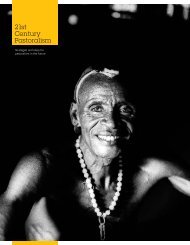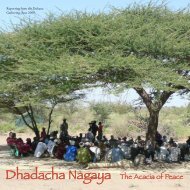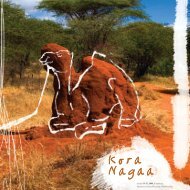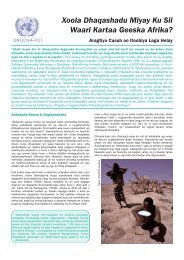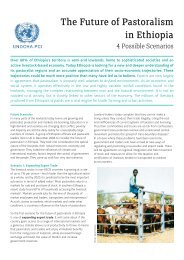Download PDF (1.47Mb) - the Website of the Pastoralist ...
Download PDF (1.47Mb) - the Website of the Pastoralist ...
Download PDF (1.47Mb) - the Website of the Pastoralist ...
Create successful ePaper yourself
Turn your PDF publications into a flip-book with our unique Google optimized e-Paper software.
ABOUT<br />
THE KARAMOJA<br />
RESEARCH<br />
3. Building <strong>the</strong> Research Team<br />
“We are youth from different groups in rural and urban areas <strong>of</strong> Moroto, Napak<br />
and Nakapiripirit. Some <strong>of</strong> us have been to school and some have not. We have<br />
experience <strong>of</strong> mining, quarrying, digging murram, raiding, peace work, brewing,<br />
herding, growing sorghum, photography, making mandazis (doughnuts), granaries,<br />
soap and jewellery, hunting, business and NGO work.”<br />
Building a research team means convening people who are interested in finding out about and taking action on<br />
a common topic and who are, as far as possible, representative <strong>of</strong> a diversity <strong>of</strong> experience and background.<br />
Diversity is important because <strong>the</strong> researchers’ own knowledge plays such an important role in action research<br />
in defining <strong>the</strong> purpose, setting <strong>the</strong> questions, framing <strong>the</strong> explanation <strong>of</strong> <strong>the</strong> research to those <strong>the</strong>y meet and<br />
interpreting what people tell <strong>the</strong>m and <strong>the</strong> data <strong>the</strong>y collect. The team can be understood not only as a group<br />
<strong>of</strong> people with a task, but also as a discussion between different perspectives with a goal <strong>of</strong> understanding<br />
something.<br />
Restless Development, wanting to enhance its work by responding to young Karimojong interests and concerns,<br />
put out an advertisement, calling for volunteers to take part in action research in Napak and Moroto Districts <strong>of</strong><br />
Karamoja. They had resources to support a process for five weeks, including bringing in facilitators and producing<br />
an illustrated book. They were also able to find resources for a final week when <strong>the</strong> researchers would take <strong>the</strong>ir<br />
findings back to discuss <strong>the</strong>m with <strong>the</strong> communities <strong>the</strong>y had visited.<br />
The facilitators stipulated that <strong>the</strong> team members should have experience <strong>of</strong> and interest in <strong>the</strong> topic, i.e., <strong>the</strong>y<br />
should be young Karimojong <strong>the</strong>mselves, and that <strong>the</strong>y should be from a variety <strong>of</strong> backgrounds and a balance <strong>of</strong><br />
schooled and unschooled. They suggested that <strong>the</strong> team should comprise about 12 people. Why 12? If a team is<br />
to generate questions that are fitting to <strong>the</strong> community, it needs to be diverse and to some extent ‘representative’<br />
<strong>of</strong> <strong>the</strong> diversity it wants to consult within <strong>the</strong> wider community. At <strong>the</strong> same time, too much diversity will be selfdefeating,<br />
as <strong>the</strong> team members must be able to get on with each o<strong>the</strong>r in achieving a demanding task. They<br />
need to have a common interest that <strong>the</strong>y agree to research toge<strong>the</strong>r. If <strong>the</strong>y have widely differing interests, <strong>the</strong>y<br />
might never agree on a purpose and a question to go out and ask. They also have to be not so many that <strong>the</strong>y<br />
cannot fit into <strong>the</strong> available transport.<br />
From more than 90 young people who volunteered to be part <strong>of</strong> <strong>the</strong> team, Restless Development created a<br />
shortlist <strong>of</strong> 20 people. The facilitators convened <strong>the</strong> 20 for <strong>the</strong> design stage. After a first day <strong>of</strong> story telling<br />
and discussion 13 people were selected for <strong>the</strong> team. The facilitators also recruited one elder, with<br />
experience <strong>of</strong> both research and Karimojong tradition, who would act as a supporter and advisor to<br />
<strong>the</strong>ir work.<br />
- 7 -



